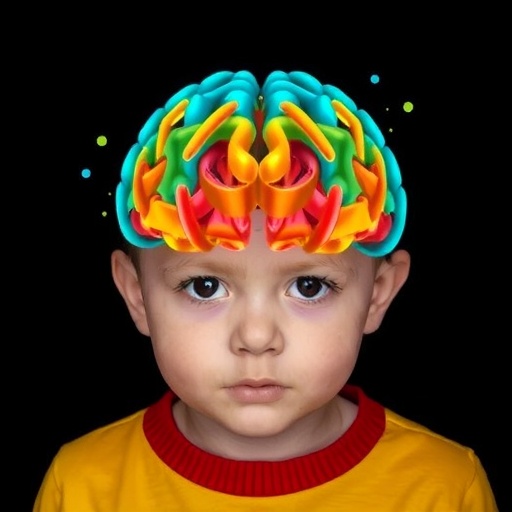Attention-deficit/hyperactivity disorder (ADHD) affects over five percent of children worldwide, presenting a significant challenge for clinicians and researchers alike. Clinically, ADHD manifests as persistent patterns of inattention, hyperactivity, and impulsivity that exceed age-appropriate behaviors. These symptoms impede academic performance and disrupt social interactions, underscoring the urgent need for a deeper understanding of the neurobiological underpinnings of the disorder. Magnetic resonance imaging (MRI) has long been the tool of choice for probing structural brain differences associated with ADHD. However, inconsistent and often contradictory findings across studies have hampered progress in identifying reliable neural biomarkers.
One major obstacle has been the variation in MRI data acquired across different sites, machines, and populations. This variability introduces measurement bias that obscures the subtle but crucial brain alterations in children with ADHD. Traditional harmonization efforts, such as ComBat, attempt to correct site and scanner differences statistically. While ComBat excels at neutralizing measurement bias, it tends to overcorrect by diminishing sampling bias—biological variability inherent to the study population. This overcorrection risks masking meaningful biological features, leading to ambiguous or conflicting conclusions about brain volume differences in ADHD.
In a groundbreaking new study, researchers from Japan introduce the traveling-subject (TS) harmonization method—a novel approach designed to disentangle measurement bias from sampling bias more effectively. The TS method leverages multiple MRI scans of the same individual obtained from different scanners to precisely quantify and correct scanner-specific measurement variations. By applying this method, the researchers achieved more accurate, harmonized brain imaging data across sites, preserving essential biological variance that traditional techniques overlook.
The study was a collaborative effort encompassing experts from the University of Fukui, Chiba University, and The University of Osaka. Assistant Professor Qiulu Shou and Associate Professor Yoshifumi Mizuno spearheaded the initiative, validating the TS method on an independent large-scale dataset. This dataset involved 14 traveling subjects who underwent scans on four distinct MRI machines from multiple institutions over several months. These reference scans enabled the researchers to isolate measurement discrepancies unique to each MRI scanner with unparalleled precision.
Following scanner bias calibration, the team applied the corrections to data from over 290 children enrolled in the Child Developmental MRI (CDM) database. The CDM database, an ambitious joint venture by the collaborating universities, aims to collect neuroimaging data on more than 1,000 children to enhance our understanding of brain development and neurodevelopmental disorders. Subjects consisted of typically developing children as well as children diagnosed with ADHD, allowing rigorous comparison of gray matter volume (GMV) across groups while accounting for site variations.
Crucially, the TS harmonization method not only reduced measurement biases significantly compared to raw data but also maintained sampling bias—preserving biological differences between individuals. This contrasts with ComBat, which although effective at measurement bias reduction, substantially reduced sampling bias and potentially diluted neurobiological signals. Such preservation of biological variance is essential for identifying genuine disease-related brain structure changes, with far-reaching implications for diagnostic imaging research.
Applying TS correction, the researchers observed robust regional gray matter reductions in the frontotemporal lobes of children with ADHD compared to typically developing peers. These brain regions are intimately involved in cognitive processes frequently impaired in ADHD, including attentional control, executive functioning, and emotional regulation. The detected volumetric decreases provide compelling evidence for structural abnormalities localized to networks underpinning core ADHD symptomatology.
The implications of these findings extend beyond academic interest. Harmonized brain imaging datasets that accurately reflect both measurement consistency and biological variability empower scientists and clinicians to identify reliable neuroimaging biomarkers. Such biomarkers could revolutionize ADHD diagnostics by enabling early and objective identification of affected children, paving the way for targeted interventions tailored to individual neural profiles. Moreover, longitudinal monitoring of these markers might gauge treatment efficacy and neurological development trajectories over time.
This study exemplifies the critical importance of addressing measurement bias in multi-site neuroimaging research. As collaborative studies expand globally, harmonization methods like TS will be indispensable for integrating data across institutions and scanner types without compromising biological insights. The synergy between methodological rigor and clinical relevance embodied in this work sets a new standard for ADHD neuroimaging and offers hope for breakthroughs in understanding and treating this prevalent disorder.
Dr. Shou emphasized, “The TS harmonization framework enables us to disentangle technical artifacts from true neurobiological signals in multi-site data, facilitating more accurate detection of brain structural abnormalities in ADHD.” Associate Professor Mizuno added, “Our results underscore the presence of distinct brain morphology alterations in key cognitive regions, reinforcing the biological basis of ADHD and guiding future personalized therapeutic strategies.”
Looking forward, the researchers advocate for wider adoption of the TS harmonization approach across neurodevelopmental disorder research. By combining robust data correction with large-scale data aggregation, the field can generate reproducible and clinically actionable findings. Ultimately, this convergence of advanced imaging methodology and neuropsychiatric inquiry holds the promise of transforming strategies for diagnosing, treating, and understanding ADHD, thereby improving outcomes for millions of affected children worldwide.
Subject of Research: People
Article Title: Brain structure characteristics in children with attention deficit/hyperactivity disorder elucidated using traveling-subject harmonization
News Publication Date: 8-Aug-2025
References:
DOI: 10.1038/s41380-025-03142-6
Image Credits: Associate Professor Yoshifumi Mizuno from the University of Fukui, Japan
Keywords: Neuroimaging, Neuroscience, Imaging, Cognitive neuroscience, Human brain, Medical imaging, Functional neuroimaging, Connectomics, Tomography, Functional magnetic resonance imaging, Nuclear magnetic resonance, Magnetic resonance imaging, Research methods, Psychological science, Cognitive psychology, Cognitive development, Learning disabilities, Brain activity maps, Attention deficit hyperactivity disorder




